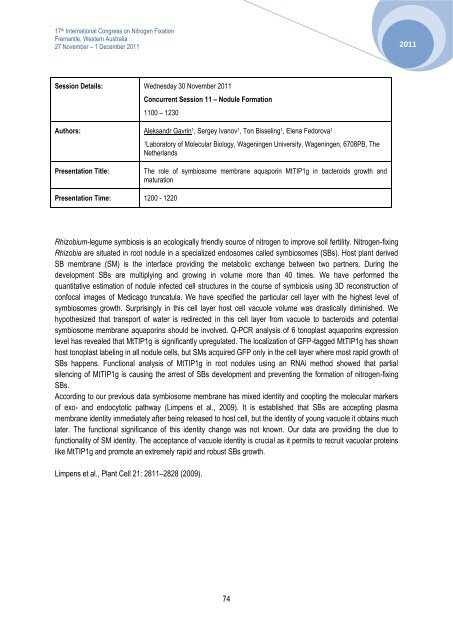IN INOCULANTS Nodulaid - 17th International Nitrogen Fixation ...
IN INOCULANTS Nodulaid - 17th International Nitrogen Fixation ...
IN INOCULANTS Nodulaid - 17th International Nitrogen Fixation ...
Create successful ePaper yourself
Turn your PDF publications into a flip-book with our unique Google optimized e-Paper software.
17 th <strong>International</strong> Congress on <strong>Nitrogen</strong> <strong>Fixation</strong><br />
Fremantle, Western Australia<br />
27 November – 1 December 2011<br />
Session Details: Wednesday 30 November 2011<br />
Rhizobium-legume symbiosis is an ecologically friendly source of nitrogen to improve soil fertility. <strong>Nitrogen</strong>-fixing<br />
Rhizobia are situated in root nodule in a specialized endosomes called symbiosomes (SBs). Host plant derived<br />
SB membrane (SM) is the interface providing the metabolic exchange between two partners. During the<br />
development SBs are multiplying and growing in volume more than 40 times. We have performed the<br />
quantitative estimation of nodule infected cell structures in the course of symbiosis using 3D reconstruction of<br />
confocal images of Medicago truncatula. We have specified the particular cell layer with the highest level of<br />
symbiosomes growth. Surprisingly in this cell layer host cell vacuole volume was drastically diminished. We<br />
hypothesized that transport of water is redirected in this cell layer from vacuole to bacteroids and potential<br />
symbiosome membrane aquaporins should be involved. Q-PCR analysis of 6 tonoplast aquaporins expression<br />
level has revealed that MtTIP1g is significantly upregulated. The localization of GFP-tagged MtTIP1g has shown<br />
host tonoplast labeling in all nodule cells, but SMs acquired GFP only in the cell layer where most rapid growth of<br />
SBs happens. Functional analysis of MtTIP1g in root nodules using an RNAi method showed that partial<br />
silencing of MtTIP1g is causing the arrest of SBs development and preventing the formation of nitrogen-fixing<br />
SBs.<br />
According to our previous data symbiosome membrane has mixed identity and coopting the molecular markers<br />
of exo- and endocytotic pathway (Limpens et al., 2009). It is established that SBs are accepting plasma<br />
membrane identity immediately after being released to host cell, but the identity of young vacuole it obtains much<br />
later. The functional significance of this identity change was not known. Our data are providing the clue to<br />
functionality of SM identity. The acceptance of vacuole identity is crucial as it permits to recruit vacuolar proteins<br />
like MtTIP1g and promote an extremely rapid and robust SBs growth.<br />
Limpens et al., Plant Cell 21: 2811–2828 (2009).<br />
Concurrent Session 11 – Nodule Formation<br />
1100 – 1230<br />
Authors: Aleksandr Gavrin 1 , Sergey Ivanov 1 , Ton Bisseling 1 , Elena Fedorova 1<br />
1 Laboratory of Molecular Biology, Wageningen University, Wageningen, 6708PB, The<br />
Netherlands<br />
Presentation Title: The role of symbiosome membrane aquaporin MtTIP1g in bacteroids growth and<br />
maturation<br />
Presentation Time: 1200 - 1220<br />
74<br />
2011


